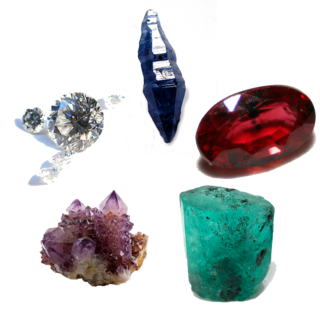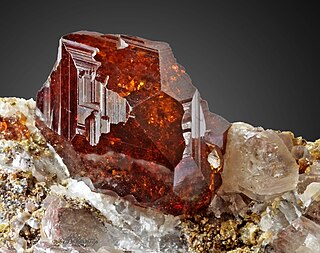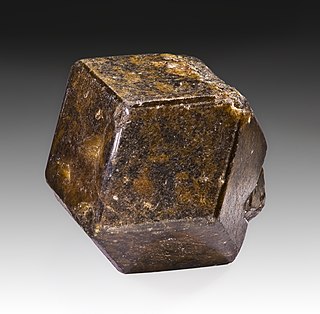Related Research Articles

A gemstone is a piece of mineral crystal which, in cut and polished form, is used to make jewelry or other adornments. However, certain rocks and occasionally organic materials that are not minerals are also used for jewelry and are therefore often considered to be gemstones as well. Most gemstones are hard, but some soft minerals are used in jewelry because of their luster or other physical properties that have aesthetic value. Rarity and notoriety are other characteristics that lend value to gemstones.

Garnets are a group of silicate minerals that have been used since the Bronze Age as gemstones and abrasives.

A ruby is a pink-ish red to blood-red colored gemstone, a variety of the mineral corundum. Ruby is one of the most popular traditional jewelry gems and is very durable. Other varieties of gem-quality corundum are called sapphires. Ruby is one of the traditional cardinal gems, alongside amethyst, sapphire, emerald, and diamond. The word ruby comes from ruber, Latin for red. The color of a ruby is due to the element chromium.

Kimberlite is an igneous rock, which sometimes contains diamonds. It is named after the town of Kimberley in South Africa, where the discovery of an 83.5-carat (16.70 g) diamond called the Star of South Africa in 1869 spawned a diamond rush and the digging of the open-pit mine called the Big Hole. Previously, the term kimberlite has been applied to olivine lamproites as Kimberlite II, however this has been in error.

Tanzanite is the blue and violet variety of the mineral zoisite, caused by small amounts of vanadium. Tanzanite belongs to the epidote mineral group. Tanzanite is only found in Tanzania, in a very small mining area near the Mererani Hills.

Almandine, also known as almandite, is a species of mineral belonging to the garnet group. Its IMA symbol is Alm. The name is a corruption of alabandicus, which is the name applied by Pliny the Elder to a stone found or worked at Alabanda, a town in Caria in Asia Minor. Almandine is an iron alumina garnet, of deep red color, inclining to purple. It is frequently cut with a convex face, or en cabochon, and is then known as carbuncle. Viewed through the spectroscope in a strong light, it generally shows three characteristic absorption bands.

Tsavorite or tsavolite is a variety of the garnet group species grossular, a calcium-aluminium garnet with the formula Ca3Al2Si3O12. Trace amounts of vanadium or chromium provide the green color.

Demantoid is the green gemstone variety of the mineral andradite, a member of the garnet group of minerals. Andradite is a calcium- and iron-rich garnet. The chemical formula is Ca3Fe2(SiO4)3 with chromium substitution as the cause of the demantoid green color. Ferric iron is the cause of the yellow in the stone.

The mineral pyrope is a member of the garnet group. Pyrope is the only member of the garnet family to always display red colouration in natural samples, and it is from this characteristic that it gets its name: from the Greek for fire and eye. Despite being less common than most garnets, it is a widely used gemstone with numerous alternative names, some of which are misnomers. Chrome pyrope, and Bohemian garnet are two alternative names, the usage of the latter being discouraged by the Gemological Institute of America. Misnomers include Colorado ruby, Arizona ruby, California ruby, Rocky Mountain ruby, Elie Ruby, Bohemian carbuncle, and Cape ruby.
The Pumpkin Diamond is a diamond weighing 5.54 carats rated in color as Fancy Vivid Orange by the Gemological Institute of America. While this may seem small when compared to other famous diamonds, the Pumpkin Diamond is, in fact, one of the largest Fancy Vivid Oranges the GIA reports having rated and is unique compared to other orange diamonds because it is light-colored and notably intense. The Pumpkin Diamond was mined in Central African Republic and then imported into South Africa for sale, it was later cut and polished by William Goldberg, and put to auction at Sotheby's where it was bought by Ronald Winston of the House of Harry Winston for the price of $1.3 million. It is currently estimated to be valued at $3 million.

Spessartine is a nesosilicate, manganese aluminium garnet species, Mn2+3Al2(SiO4)3. This mineral is sometimes mistakenly referred to as spessartite.

Grossular is a calcium-aluminium species of the garnet group of minerals. It has the chemical formula of Ca3Al2(SiO4)3 but the calcium may, in part, be replaced by ferrous iron and the aluminium by ferric iron. The name grossular is derived from the botanical name for the gooseberry, grossularia, in reference to the green garnet of this composition that is found in Siberia. Other shades include cinnamon brown (cinnamon stone variety), red, and yellow. Grossular is a gemstone.

Andradite (IMA symbol: Adr) is a mineral species of the garnet group. It is a nesosilicate, with formula Ca3Fe2Si3O12.

Rhodolite is a varietal name for rose-pink to red mineral pyrope, a species in the garnet group. It was first described from Cowee Valley, Macon County, North Carolina. The name is derived from the Greek "rhodon" for "rose-like", in common with other pink mineral types. This coloration, and the commonly inclusion-free nature of garnet from this locality, has led to rhodolite being used as a gemstone. Rhodolite like other varietal names is not officially recognized as a mineralogical term, but rather used as an accepted trade name.

Hydrogrossular is a calcium aluminium garnet series (formula: Ca3Al2(SiO4)3−x(OH)4x, with hydroxide (OH) partially replacing silica (SiO4)). The endmembers of the hydrogarnet family (grossular, hibschite, and katoite) depend on the degree of substitution (x):

The Aurora Butterfly of Peace diamond collection is an artwork consisting of 240 natural, fancy colored diamonds weighing a combined total of 167 carats (33.4 g). This butterfly-shaped diamond mosaic was created over a period of twelve years by Alan Bronstein and Harry Rodman. The Aurora Butterfly of Peace was conceived as an eternal icon of love, beauty, energy, nature and peace.
Gadolinium Gallium Garnet is a synthetic crystalline material of the garnet group, with good mechanical, thermal, and optical properties. It is typically colorless. It has a cubic lattice, a density of 7.08 g/cm3 and its Mohs hardness is variously noted as 6.5 and 7.5. Its crystals are produced with the Czochralski method. During production, various dopants can be added for colour modification. The material is also used in fabrication of various optical components and as a substrate material for magneto–optical films. It also finds use in jewelry as a diamond simulant. GGG can also be used as a seed substrate for the growth of other garnets such as YIG.

Gore Mountain Garnet, found in the Adirondack mountains in New York, contains the world's largest garnets. The rock that holds these garnets, garnet amphibolite, is sometimes referred to as 'black ore' or 'dark ore.' This rock formation formed during metamorphism during the Ottawan Orogeny, and extremely high temperatures combined with introduction of fluids is what most likely contributed to the unusual size of the megacrystic garnets.
Malaia may refer to:
References
- 1 2 3 4 5 6 7 8 9 10 11 12 13 14 (Gia), Gemological. Gem Reference Guide. City: Gemological Institute of America (GIA), 1988. ISBN 0-87311-019-6
- ↑ Garnet(Almandine, Rhodolite, Pyrope, Demantoid, Tsavorite, Hessonite, Grossular, Spessartine) Course notes at the Department of Geological Sciences, The University of Texas at Austin website, accessed January 27, 2007